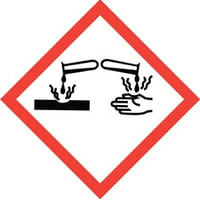Farm safety
It's important to be vigilant if you notice a leak or spillage of GasAbate on your farm
GasAbate
Hydrogen peroxide safety guide for farmers


Reminder: Never work alone when handling hydrogen peroxide. Always wear PPE, know where your spill kit is, and brief all farm staff on these procedures. Proper storage and prompt action can prevent serious injury or environmental damage.
--------------------
1. Recognise the hazard
- Hydrogen peroxide (35%) is a strong oxidiser – it can intensify fires and react dangerously with fuels or organic matter.
- It causes serious eye damage, skin burns and respiratory irritation if inhaled.
--------------------
2. Personal protection before approaching a spill
- PPE required:
- Chemical-resistant gloves (butyl or equivalent).
- Rubber apron or chemical-resistant overalls.
- Safety goggles and a full-face visor.
- Waterproof boots.
- If indoors or ventilation is poor, use a respirator with ABEK/P3 filter.
- Ensure another person is present before starting clean-up.
--------------------
3. Immediate actions for a spill or leak
- Keep people and animals away from the area. Evacuate children and livestock.
- Ventilate the area if indoors – open doors and windows.
- Stop the source if it can be done safely (eg, close a valve or upright a container).
- Do NOT touch spilled material without PPE or mix it with fuels, manure or other chemicals.
- Contain the spill:
- Use sand, soil or an absorbent from the spill kit (stored near the bulk container as required).
- Prevent liquid entering drains, waterways or soil.
- Collect absorbed material into a clean plastic container or drum labelled “Hydrogen Peroxide Waste”. Never return spill product to the bulk container.
--------------------
4. Clean-up and disposal
- Rinse the contaminated surface with plenty of water after removing the bulk liquid.
- Dispose of collected waste and used PPE via your regional hazardous waste contractor.
- Report the incident to GlasPort Bio or your GasAbate service contact.
--------------------
5. If hydrogen peroxide contacts a person
- Skin or hair: Remove contaminated clothing immediately. Rinse skin with plenty of water/shower. Seek medical attention if irritation persists.
- Eyes: Rinse cautiously with water for at least 15 minutes. Remove contact lenses if easy to do. Get medical help immediately.
- Inhalation: Move the person to fresh air. Seek medical help urgently if symptoms occur (coughing, dizziness, breathing difficulty).
- Ingestion: Rinse mouth, give water to drink, do NOT induce vomiting, and call a doctor immediately.
--------------------
6. Fire or explosion risk
- Hydrogen peroxide supports combustion. If nearby materials catch fire:
- Evacuate the area.
- Fight fire remotely with water only if safe to do so.
- Inform emergency services that hydrogen peroxide is involved.
--------------------
7. Storage and prevention
- Store IBCs on a bunded stand (minimum 1100 L capacity) to catch leaks.
- 5,000 L bulk tanks provided are bunded to cover 110% capacity.
- Keep containers cool, shaded and well-ventilated. Protect from heat and sunlight.
- Do not store near fuels, reducing agents or metal salts.
- Always follow written instructions for safe connection/disconnection of IBCs/bulk tanks, and keep the spill kit next to the storage area.
--------------------
8. Emergency contacts (local numbers)
- GlasPort Bio: +353 (0) 83 365 0623
- Poisons Information Centre of Ireland (www.poisons.ie): +353 (0) 1 809 2166 (8am to 10pm)
- Swedish Poisons Information Centre (www.giftinformation.se): +46 (0) 10 456 67 00
- Local emergency services (Ireland): 999
- Local emergency services (EU): 112
